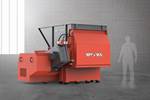Internally Lubricated Olefinic Alloy Helps Prevent Buzz-Squeak-Rattle Noise in Automotive Interiors
SABIC’s new Lubriloy N2000 compound poised as drop-in for standard PC/ABS for reduced friction and stick-slip behavior between molded parts
A proprietary internally lubricated compound that reportedly helps prevent buzz-squeak-rattle (BSR) noise in automotive interiors, has been developed by SABIC. Based on an amorphous blend, LNP Lubriloy N2000 offers both molded-in color capability and paintability. A compatibilized olefinic alloy, free of silicone and PTFE, is being poised as an innovative drop-in alternative to standard PC/ABS that enables automotive OEMs and tiers to significantly reduce friction and stick-slip behavior between molded parts to limit or prevent unwanted noise.

SABIC’s lubricating technology is said to enable the Lubriloy N2000 compound to deliver a low coefficient of friction (COF) and excellent wear performance in plastic parts moving over metal and plastic surfaces. When evaluated using the BSR test VDA 230-206, the N2000 compound demonstrated a risk priority number (RPN) of less than 3 versus non-modified PC/ABS materials that typically have values greater than 5. In addition to automotive interior parts – such as mirror housings and trim, cupholders, button guides and HVAC frames – the new material can potentially be used in consumer electronics applications where reduced friction or improved wear is required.
Said LNP Compounds’ senior product manager Ed Williams, “A quiet, smooth ride is a hallmark of automotive quality and luxury, but cabin sounds can be more noticeable in electric and hybrid vehicles due to the absence of source noise from their powertrains. Our new LNP Lubriloy N2000 compound is highly effective at limiting buzz-squeak-rattle noise and eliminates the need for secondary applications such as felts or tapes. This latest material innovation helps our customers provide a more enjoyable driving experience for consumers.”
In July 2020, the EU placed limitations on the amount of industrial surfactant PFOA, commonly used during the production of PTFE, that can be present in a material. Suppliers now must certify that materials containing PTFE fall below the recommended PFOA threshold (<25 ppb). With Lubriloy N2000 compound, manufacturers can now emulate the tribological performance of traditional lubricated materials while avoiding the use of PTFE and, therefore, any trace impurities from PFOA that may be present.
The new LNP compound offers molded-in color in custom shades that can be difficult to achieve with other commercially available compounds utilizing solid lubrication packages like graphite or molybdenum. Paintability is an additional feature of the N2000 compound and addresses the challenge often found with traditional silicone-based materials since the silicone oil can cause surface defects. To further assist automotive designers, SABIC is also developing next generation lubricated LNP materials in stylish deep glossy black colors.
Related Content
-
What's the Allowable Moisture Content in Nylons? It Depends: Part 2
Operating within guidelines from material suppliers can produce levels of polymer degradation. Get around it with better control over either the temperature of the melt or the barrel residence time.
-
The Fantasy and Reality of Raw Material Shelf Life: Part 1
Is a two-year-old hygroscopic resin kept in its original packaging still useful? Let’s try to answer that question and clear up some misconceptions.
-
How Do You Like Your Acetal: Homopolymer or Copolymer?
Acetal materials have been a commercial option for more than 50 years.














